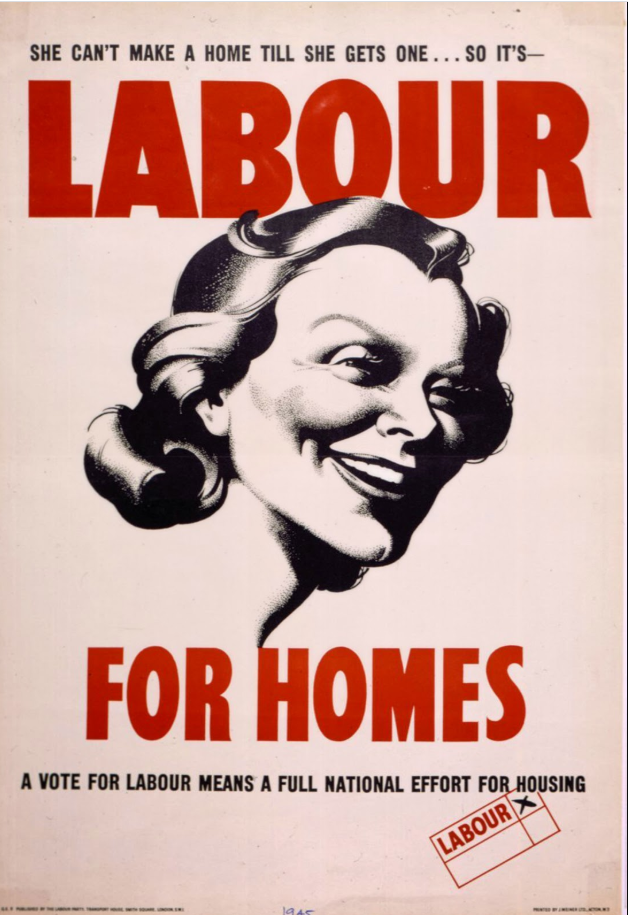Seventy-five years ago, Britain was in the midst of a General Election that would transform the country for generations to come. And Clement Attlee’s 1945 landslide General Election victory was built on the foundations of Labour’s housing, construction and town planning policies.
To mark the 75th anniversary of Labour’s 1945 General Election victory, Paul Dimoldenberg introduces his new book:
‘Cheer Churchill. Vote Labour’ – The story of the 1945 General Election.
In 1945, the British people took a very practical view of the future. They wanted a decent home, a job and not to have to worry when they became ill or fell on hard times. In short, they wanted a better life and saw Labour as the vehicle through which these aspirations could be achieved.
Labour promised ‘bread and butter’ improvements which secured the votes of working-class and middle-class families. With over 2 million houses damaged or destroyed by the blitz, over half of them in London, the scale of destruction throughout Britain explained the desperate need for new homes. Again, and again, homes and jobs were foremost in the minds of voters. Labour recognized these as the priorities. And the voters believed Labour would provide them. The Labour Manifesto promised:
“Housing will be one of the greatest and one of the earliest tests of a Government’s real determination to put the nation first. Labour’s pledge is firm and direct – it will proceed with a housing programme with the maximum practical speed until every family in this island has a good standard of accommodation. That may well mean centralising and pooling of building materials and components by the State, together with price control. If that is necessary to get the houses as it was necessary to get the guns and planes, Labour is ready.
And housing ought to be dealt with in relation to good town planning – pleasant surroundings, attractive lay-out, efficient utility services, including the necessary transport facilities.
There should be a Ministry of Housing and Planning combining the housing powers of the Ministry of Health with the planning powers of the Ministry of Town and Country Planning; and there must be a firm and united Government policy to enable the Ministry of Works to function as an efficient instrument in the service of all departments with building needs and of the nation as a whole.”
In Cardiff, James Callaghan recalled:
“Most questions were about demobilisation from the Forces or housing shortages. In my innocence and good faith, I promised rapid action on both and during the campaign my main slogan became: ‘We built the Spitfires. Now we can build the houses’”.
In Bishop Auckland, Hugh Dalton remembered:
“The big issues were pensions, housing and fear of a return to pre-war unemployment.”
At Ebbw Vale, Aneurin Bevan, picking up on the mood of the times, argued that:
“Low rents, spacious homes fitted with all the labour-saving appliances invented by modern domestic science, can be made available to all only if the task of house-building is organized on a national plan”.
In Preston, the Conservative MP, Julian Amery, described the grim reality for many:
“Much the biggest issue was housing. No new houses had been built since the war and there was fearful overcrowding. It was quite common to find eleven or twelve people sleeping in a single room, and in many of the slum districts there was virtually no sanitation”.
Winston Churchill’s daughter, Sarah, describes the day-to-day impulses that led many to put their trust in Labour. In a letter to her father, she explained that:
“The people I know who are Labour, don’t vote Labour for ideals or belief, but simply because life has been hard for them, often an unequal struggle, and they think that only by voting Labour will their daily struggle become easier. They are all decent people who want an easier and gayer life”.
The historians are in full agreement. A.J.P. Taylor recognized the main concerns of the electorate:
“They cared only for their own future: first housing, and then full employment and social security. Here Labour offered a convincing programme”.
Arthur Marwick concurred:
“Public opinion polls showed that the issue which most concerned people was housing. Labour effectively presented itself as the party most strongly committed to social reform.”
Angus Calder agrees:
“Labour had been elected, above all, on the issue of housing”.
This was ‘retail politics’ at its most potent. As the historian Paul Addison concludes in ‘The Road to 1945’:
“A simple but vital point about the 1945 election is that Labour put the material needs of the average family above all else in its campaign”.
And Labour delivered. Over the next 5 years, Labour built one million new homes.
Of course, the situation in 2020 is radically different to the challenges of 1945. But there are some real parallels.
Recent analysis by Nathaniel Barker for ‘Inside Housing’ has revealed that areas with the most overcrowded housing have been worst hit by COVID-19. The area with the highest COVID-19 death rate (144.3 deaths per 100,00) and the biggest housing overcrowding problem (25.2% of homes are overcrowded) – is Newham in east London. Just as with the wartime blitz, there is a clear London focus to the problems caused by overcrowding. Of the 30 areas with the highest percentages of households living in overcrowded conditions, Barker explains:
“26 are in London. Part of that can likely be explained by the acute affordable housing shortages in the city”
Over the next few years, Labour needs to learn from the 1945 experience, put the needs of the people at the forefront and develop a social housing programme for the 2020s and beyond.
‘Cheer Churchill. Vote Labour’ – The story of the 1945 General Election is available in e-book and paperback format at: https://www.amazon.co.uk/dp/B08975HFS7/ref=cm_sw_r_tw_dp_U_x_4Xc2Eb4B0AVT1 via @AmazonUK
All proceeds from the sale of the book will be donated to Foodbanks in Westminster.


2 replies on “We built the Spitfires. Now we can build the houses.”
I am one of the generation who benefited from Labour’s post war housing policies. I was born in 1943 and my father, following demobilisation returned to his job as a bricklayer helping to build the homes the nation needed. I followed my father’s lead and worked in the industry all my working life. I would love to see a government that was serious about solving the housing crisis. However, we live now in a different situation from WW2, then 50% of our GDP was devoted to the war effort. Now we need to devote 10% of GDP to ensure that all new buildings are truly net zero carbon, and our 26 million existing homes are retrofitted to as near net zero as possible. To achieve this and prevent catastrophic climate change we need to train over a million construction workers starting now!
[…] Paul Dimoldenberg was first elected to Westminster City Council in 1982. He was Leader of the Labour Opposition Group from 1987-1990 and from 2004-2015. He is the author of ‘The Westminster Whistleblowers’, published by Politicos in 2006, which tells the story of the Westminster ‘Homes for Votes’ scandal of the 1980s and 1990s. He also has recently published Cheer Churchill. Vote Labour. […]